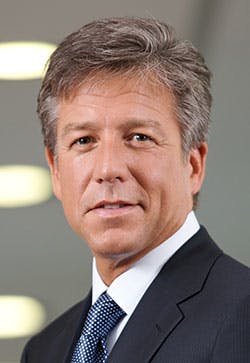When Bill McDermott’s little brother Kevin, 6 feet tall and 225 pounds, hefted the 6-foot, 2-inch, 165-pound Bill, outfitted in one of his two $99 suits, and carried him through 4 feet of flood water to their Dad, who was waiting to drive the future CEO to the train, it was all part of the promise, part of the dream.
“When did you first make this dream your goal?” I asked McDermott, now CEO of SAP, the world’s third largest software company. “It was on the train ride in,” he explained. “I wanted to be the next David Kearns (Xerox’ CEO 1982 to 1990).”
Long after Sister Jean Agnes pulled his father aside with “just don’t expect too much of him …he’ll probably be a mechanic, or maybe a truck driver,” McDermott was learning what he needed to make that train ride. From flinging newspapers onto the steps of sleeping customers, selling cookies, waiting tables at Amado’s, and then buying a deli in high school for $5,000, every movement, every step, every conversation carried him forward.
Yes, there were setbacks -- McDermott did not walk a straight line to the top -- just read his book's opening paragraph, which drew me into his story:
I hear my little brother yell, so I whip my head around and see smoke coming down our short staircase. Kevin is upstairs getting ready for bed. Our baby sister, Gennifer, is sleeping in the adjacent room at the back of our small house. Mom and I are in the kitchen washing dishes, and my father is working the night shift at Con Edison.
I race after my mom to the top of the stairs, where we see the flames.
This is real, I think. I am twelve years old, and our house in on fire. We gotta move.
The DNA of Work Life
"Why did you write this book?" I asked, because this work is courageous and colorful, not the typical business leadership tome. It's a personal story, and the story is real.
“I thought about my own life,” McDermott said. “The seed is planted very young -- the seed of working and winning. On that train ride into the city I knew it -- I wanted to be the next David Kearns."
"We would go to these great universities and talk with students, and what struck me about young, brilliant, amazing people with great pedigrees was that they were really bright, but they were looking for insight."
"The DNA of work life starts very young -- paperboy, cookie sales, the deli, the train ride in the $99 suit -- all these seeds came out when I was older. So I knew this was the right time to write this book, not to wait until I was 70."
“And the other thing that struck me is that people are dying for stories. In fact, they would say to me, 'tell me some real stories.' Winners Dream is dedicated to giving those dreamers who want to be winners an edge.”
SAP CEO Bill McDermott on setting strategy and getting people to follow it. "If you have a 50-year-old company, the things that got you from there to here will definitely not get you from here to there. So you have to change."McDermott's Personal Journey
McDermott came from tough times, from a house beside a canal on Long Island that periodically overflowed and flooded his living room, along with a series of losses that could have broken his family.
"I realized we had it a lot better than other people," he said. "Still there were tough times"
Along the way the future McDermott had to build his network, sell and beat all sales quotas, and always, always, "figure out who the real boss was." And every time that it counted, the real boss turned out to be the customer.
The train ride took McDermott to a Xerox corner office, but after 17 years there, he said, "At 36 I was a made person. I had stopped learning at Xerox. I wanted to get into the new economy -- analysis, the numbers, to learn more. And Gartner, (where he became president), was the voice for info tech at that time -- the industry was really getting broader and smarter."
When the dotcom bubble was rising, a headhunter approached McDermott to take a big position in one of the new start-ups. "The call came in, and I told my wife to tell the headhunter that I was stuck in a snow-drift -- but it wasn't snowing! -- so I had to pick up the phone. The offer was for a lot, a lot of money, but I said 'no,' and I told the recruiter why -- 'If I take this job, I'm only taking it for the money.' And I hung up."
"Honey, I just blew a billion."
"The job wasn't for you," his wife replied. "You're bigger than the money."
"That dotcom offer stung -- It took some guts," McDermott recalled. "I had to take a breath, steel myself, to say 'no'. Although I saw people hitting the jackpot in dot.coms, it wasn't real, and I knew it. I remembered Sister Jean Agnes' warning to my Dad, 'Don't expect too much,' and I was glad I had been able to outrun her."
Next stop was Gartner, where as president McDermott strode into the digital age, digging into the numbers and how they were derived. It was a necessary passage that partnered well with his people and networking skills, along with his drive.
But at this point in his story, many readers will be watching for the thunderbolt -- his journey had to this point been so straight and direct, so perfectly well-groomed and lucky, so driven by hard work, one becomes uneasy.
And BOOM! The thunderbolt strikes. His wife Julie, struck by cancer. Suddenly McDermott's world had limits, exhausting days followed by bad nights. "Alone on that dark hill up in Connecticut, with two little kids depending on me, it was grim, pretty grim."
Relief came in the form of a call to sunny California from Siebel Systems. His wife's cancer caught in time, at this point McDermott had feet firmly planted in the tech world, and again, momentum and drive were in his favor.
Siebel led to him to SAP, the third largest software company in the world (Microsoft is No. 1, and Oracle, No. 2), a company that is being reinvented with HANA, the differentiator.
In May of 2014 he was named CEO of SAP.
There's the Cloud, and then there's The Cloud
We asked McDermott what he felt moving SAP to HANA (High-Performance Analytic Appliance) would do for the industries and customers the company serves.
"HANA is to the enterprise what Google is to the internet," McDermott replied. "Just as Google surfs the internet for instantaneous information, HANA delivers data as information we can use. With ubiquitous sensor, camera, satellite [and other] data doubling every 18 months, corporations are flooded with data, lots of unstructured data. For example, in the car business, the web will tell me how many cars we sold today versus how many were sold in China, and that's clear. But there are also tons of unstructured data out there, and we need a way to sift that data into information that the customer needs."
What is HANA?
He continued: "HANA can take structured and unstructured data, compress it -- it's a software appliance that runs simply -- and turn it into what you need to know. It knows what you ask, what you need, and goes to the right place to pull in the information. We don't use stacks of disks, we compress data."
The concept is radically different from the bricks and mortar Cloud composed of racks of disks and servers.
The Challenge -- and Benefits -- of Change
"The biggest challenge of moving to HANA," says McDermott, is that it is "so fundamentally transformative one can easily underestimate the teaching, communications and learning [needed] for the world to catch up. The second challenge was having all the competition say it was technically not possible. But today of course, they have run out of reasons because it's now the fastest selling software package in the world. The sales have validated the in-memory story. HANA can [help you] completely rethink how you do business."
Early criticism of SAP manufacturing software was that it was "inflexible; too hard to learn. If you don't fit the template you're stuck... that using the system was the primary focus -- which screen, how to get there, mental translations of terminology -- all got in the way of effective use in the business. It worked, but you had to work at it."
McDermott's mantra; "Run simple; and eliminate complexity," is his response to the critics. "In most companies, 90% of the IT budget is spent on keeping the trains running on time," McDermott explained. "But now you can shift it to sixty-forty, increase your clock speed, rethink the way you organize information, and give your customers much better service."
"And there are so many important applications -- in banking we can manage risk and compliance better, maybe catch a bad actor before the damage is done. In the healthcare sector, we can do custom DNA matching without waiting months for a solution -- think of what it would mean to have a doctor develop a particular solution to your individual chemistry and history. Or take Medicare fraud -- some estimates put it at 40%. So now we can solve different kinds of problems like these. HANA is the tool -- I call it the great simplifier."
Complexity is a killer
"As for complexity, I have a human perspective on what complexity does to people's work and their lives," McDermott added. "We waste billions of dollars on complexity, and it's taking a toll at work. People have millions of ideas, but in most IT departments the hard part is simplifying and finishing what you started."
"I also think that complexity kills hope -- it prevents people from getting a life and it keeps them from having weekends! People love their jobs, but complexity robs them of their weekends because 40% of their workweek goes to complexity. And complexity holds your data hostage. With HANA, it's all about 'Run Simple.' Simplicity will set you free."






